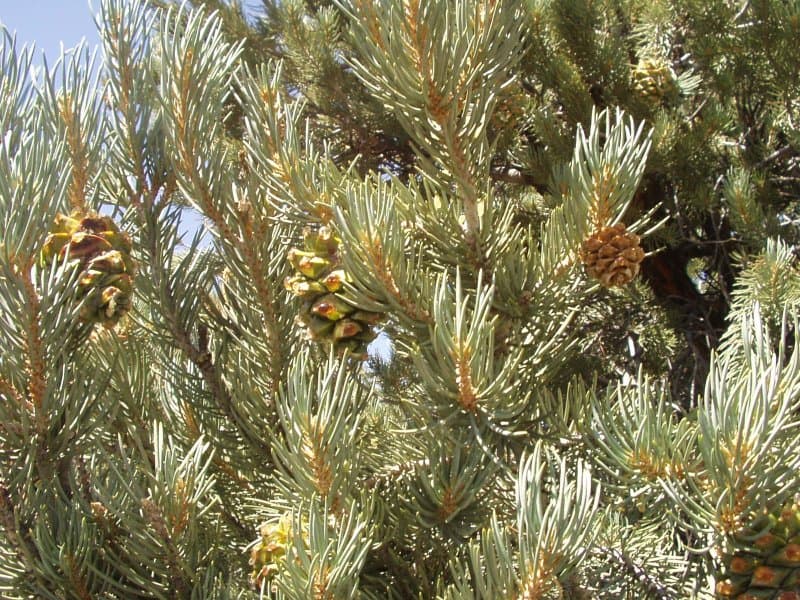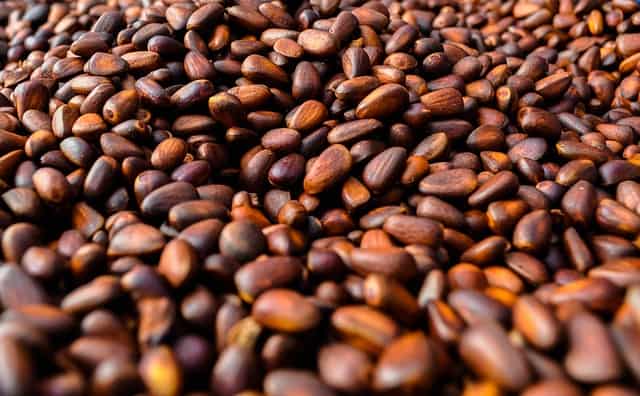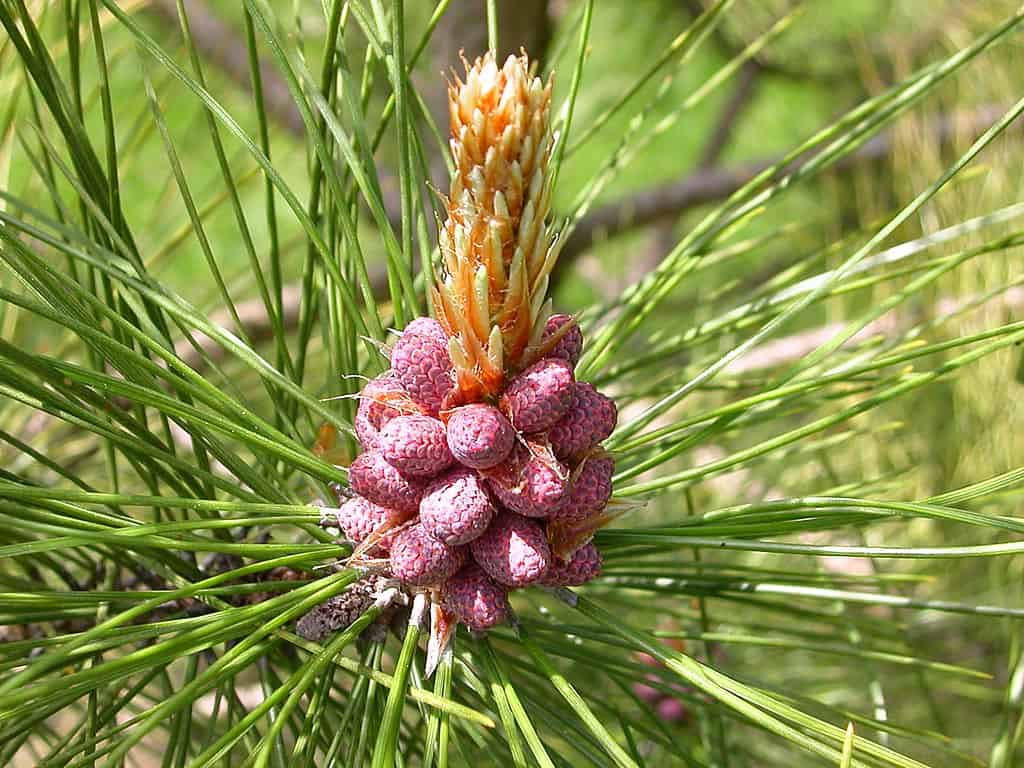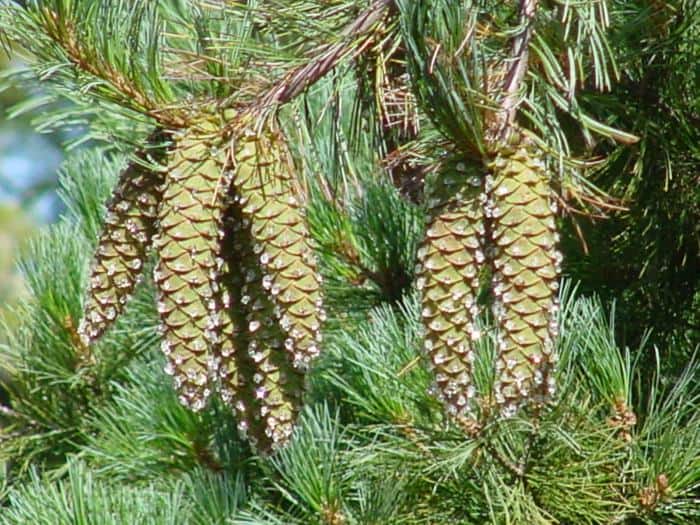There are more than one hundred different types of pine trees. It’s no surprise, then, that pinecones are a common sight in many parts of the world, particularly in areas where coniferous trees grow. In North America, we often associate pinecones with Christmas trees, holiday decorations, and snow. While pinecones are typically known for their decorative value or as a natural material for arts and crafts, some outdoorsy people may wonder whether they are an edible food source.
Are there edible pine trees? What if it was a survival situation? Should we (or could we) eat other parts of pine trees?
In this article, we will explore whether pinecones are safe for consumption, the nutritional value of pinecones, and any potential health risks associated with eating pinecones.

Are Pinecones Edible?
Pinecones are composed of woody structures with sharp edges. Eating pinecones can be dangerous and may pose a number of health risks. Pinecones are made up of tough, fibrous material that is difficult to digest and can cause damage to the digestive system. Additionally, pinecones may contain harmful chemicals, such as terpenes, that can cause digestive upset, irritation, or other health problems.
In some cases, eating pinecones can cause choking or intestinal blockage. This can be particularly dangerous for young children or individuals with pre-existing digestive conditions.
In addition to the potential health risks associated with consuming pinecones, it is also worth noting that many pinecones are treated with pesticides or other chemicals during the growing process. These chemicals may remain on the surface of the pinecone or inside the pinecone scales, making them unsafe for consumption.
While it is technically possible to eat pinecones, it is not recommended due to the potential health risks involved.
If you’re going to experiment with eating pinecones, we should clarify right away that this should be done cautiously and with a lot of forethought.
With that warning out of the way, we can get into more detail about what foragers look for when they are checking out pinecones.
This first scenario is rare and not something most outdoor enthusiasts will try, but we’ll get this one out of the way first. There are some green female pine cones that are technically edible. They are tightly closed. These green pine cones can be boiled. This softens them up enough to make them something you can technically digest. This may only be appealing in a survival situation where you are then able to correctly identify them and boil them, so again, it’s a stretch. But you could!
Mostly, when foragers talk about eating pinecones, they are talking about eating the seeds.

Edible Seeds From Pine Trees
Pine nuts (also called pine seeds) can be found inside young female pine cones. You’ll need to cut the pine cones open to access the seeds. When toasted, pine seeds have a nutty flavor that most people find enjoyable. Pine seeds can be eaten raw, they just taste better to most people when toasted. They are typically used to make pesto. They are also eaten on salads. Pine nuts are commonly used in Mediterranean and Middle Eastern cuisine and are prized for their delicate flavor and crunchy texture.
However, it is important to note that pine nuts are not the same as pinecone scales or bracts, which are the hard, woody structures that make up the pinecone itself. Pinecone scales do not provide any nutritional value and should not be consumed.
Pine nuts aren’t just tasty, they are also nutritious. The seeds contain vitamin k, vitamin C1, magnesium, carbs, fats, and protein.
People have competition when it comes to finding edible pine seeds. They are a favorite food source for squirrels and many varieties of birds, including woodpeckers.
When foraging for pine seeds, you need to first identify the pine tree you are looking at. As mentioned above, there are over a hundred species of pine trees. Edible pine seeds come from longleaf pine, sugar pine, red pine, pitch pine, and western white pine.
Pine Nut Syndrome
While rare, consuming pine nuts can occasionally cause a temporary condition known as pine nut syndrome. This is sometimes called pine mouth. A day or two after eating the pine nuts, those afflicted notice a bitter taste in their mouth. Sometimes this is a metallic taste. A few days after eating the pine nuts, the taste appears and is worsened whenever the person eats or drinks. The condition lasts for up to a few weeks. So far, there haven’t been any noticeable lasting effects past this rough period.
Do Not Eat Pine Seeds From These Species Of Pine Trees
The list of trees you cannot eat pine seeds from is long, so you need to be very careful. Do not eat the pine seeds from ponderosa pine, lodgepole pine, yellow pine, or Norfolk island pine. At this time, not enough is really known about the safety of eating pine seeds from these species. It’s better to be safe than sorry.
Do not eat anything from a yew pine tree, either. The yew pine tree appears to be unsafe for humans and most animals.


Female Pinecones Versus Male Pinecones
Not all pinecones have pine seeds. You’ll also find ones that just have pine pollen. The male pine cones contain pollen, which fertilizes the female pine cones. When fertilized, the female cones produce seeds, which then create more pine trees. The pollen cones (male) are smaller than the seed cones (female). It’s the female cones and their pine seeds, or edible pine nuts, that foragers typically eat.
Are Pine Needles Edible?
The best way to enjoy pine needles is with pine needle tea. Foraging for pine needles and making pine needle tea is a rewarding and enjoyable activity for anyone who loves nature and the outdoors. Like with any tea, all you need is hot water and the pine needles themselves. (Important note: like with the pine seeds, it is only safe to consume pine needle tea made from needles from specific species of pine trees. We’ll get into specifics below.)
One of the best things about pine needle tea is that the hot water brings out the scent. Pine needle tea smells like being in the mountains or sitting next to a Christmas tree and a fireplace.
Pine trees are widely distributed across the world, and they offer a variety of benefits to both humans and wildlife. Pine needles, in particular, have been used for centuries for their medicinal properties, and they are a rich source of vitamin C and other nutrients. Native Americans have used pine needle tea to treat infections, fevers, coughs, and other flu symptoms. Settlers quickly picked up the practice and used pine needle tea as a way to prevent scurvy.
When foraging for pine needles, it is important to identify the right species of pine tree. The most commonly used species for making pine needle tea in North America are the eastern white pine and the Scots pine.
It is important to avoid any pine trees that have needles growing in clusters of four, as these are not suitable for making tea. Like with the pine seeds, avoid anything coming from the yew tree, lodgepole pine, or ponderosa pine.
When you’re sure you have a safe tree, you can collect needles. To harvest pine needles for tea, choose young, tender needles that are light green in color. Older needles that have turned brown or yellow are not as flavorful and may have a bitter taste. It is best to avoid needles that have fallen to the forest floor. You want to harvest them fresh from the tree.
Once you have harvested your pine needles, it is important to wash them thoroughly to remove any dirt or debris. You can do this by rinsing them under cool, running water or by soaking them in a bowl of water for a few minutes. After washing, pat the needles dry with a clean towel or let them air-dry for a few hours.
To make pine needle tea, start by boiling water in a pot or kettle. Add a handful of pine needles to the water and let them steep for 10-15 minutes. You can adjust the amount of needles you use depending on your personal preference for the strength of the tea. Some people also like to add other herbs or spices to their pine needle tea, such as cinnamon or honey, to enhance the flavor.
Pine needle tea has a fresh, invigorating taste that is reminiscent of the outdoors. It is a popular choice for people who want to boost their immune system or relieve cold and flu symptoms. Pine needles are rich in antioxidants and have anti-inflammatory properties, making them an excellent natural remedy for a variety of ailments.
Aside from its medicinal properties, pine needle tea is also a great way to connect with nature and appreciate the beauty of the natural world. Foraging for pine needles is a fun and sustainable activity that allows you to explore your local environment and learn about the plants and wildlife that call it home. It is important to forage responsibly, however, and to only take what you need while leaving plenty behind for the tree to thrive.
Whether you are looking to boost your health or simply enjoy the taste of this refreshing tea, pine needles are a versatile and natural ingredient that you can easily find in your local environment. So next time you are out in nature, bring a couple of trusted field guides with you and take some time to look for pine trees and explore the many possibilities that this humble plant has to offer.
Is Pine Bark Edible?
Foraging for pine bark is a lesser-known activity, but it can be just as rewarding and beneficial as foraging for other wild edibles. If you’re already out foraging pine needles, this may be of interest as well. Like pine needles, pine bark is rich in antioxidants, vitamin C, and other nutrients, and it has been used for centuries in traditional medicine for its many health benefits.
To forage for pine bark, start by identifying the right species of pine tree. Like with pine needles, you need to avoid certain trees, especially the ponderosa pine. Ponderosa has orange-brown bark that is patterned with long, vertical ovals.
Once you’ve identified safe pine trees, you’ll want to collect bark from several. It is important to only take small pieces of bark from several different trees and to avoid damaging the tree or removing too much bark from any one spot. It’s unfortunately easy to damage a pine tree by taking too much because you’ll want to get to the inner bark.
You can eat pine bark raw, but it may end up really hurting your stomach. Stomach cramps are a common symptom after eating raw inner pine bark. Usually, people want to boil this. It makes it easier to digest.
Pine bark can be used in a variety of ways, depending on your personal preferences and needs. Some people like to grind the bark into a fine powder and use it as a seasoning or spice, while others prefer to steep it in hot water to make tea.
Pine bark tea has a woody, slightly bitter taste that is similar to other herbal teas. It is a popular choice for people who want to boost their immune system, lower their blood sugar levels, or reduce inflammation.
Should People Eat Pinecones?
In summary, pinecones are not edible and should not be consumed by humans. Pine needles and the inner bark of pine trees can be used to make teas. The seeds or pine nuts inside the pinecone are edible and nutritious and a popular food source. However, when it comes to pinecones themselves, the hard, woody structures that make up the pinecone are not safe for consumption.
If you are looking for a nutritious and safe source of wild food, it is best to look elsewhere. While pine nuts can be a tasty and healthy addition to many dishes, pinecones themselves are best left for decorative purposes or as a natural material for arts and crafts.
Recent Posts
The only venomous snakes in Washington State are Northern Pacific Rattlesnakes. The Northern Pacific Rattlesnake (Crotalus oreganus oreganus) is a sub-species of the Western Rattlesnake. Anyone...
Skunks are not classified as true hibernators. But they go into a state of torpor when the weather gets cold. Skunks are light sleep hibernators, along with opossums, bears, and raccoons. ...

